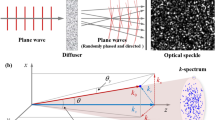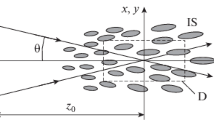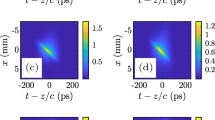Abstract
The memory effect has seen a surge of research into its fundamental properties and applications since its discovery by Feng et al. [Phys. Rev. Lett. 61, 834 (1988)]. While the wave trajectories for which the memory effect holds are hidden implicitly in the diffusion probability function [Phys. Rev. B 40, 737 (1989)], the physical intuition of why these trajectories satisfy the memory effect has often been masked by the derivation of the memory correlation function itself. In this paper, we explicitly derive the specific trajectories through a random medium for which the memory effect holds. Our approach shows that the memory effect follows from a simple conservation argument, which imposes geometrical constraints on the random trajectories that contribute to the memory effect. We illustrate the time-domain effects of these geometrical constraints with numerical simulations of pulse transmission through a random medium. The results of our derivation and numerical simulations are consistent with established theory and experimentation.
Article PDF
Similar content being viewed by others
Avoid common mistakes on your manuscript.
References
S. Feng, C. Kane, P.A. Lee, A.D. Stone, Phys. Rev. Lett. 61, 834 (1988)
R. Berkovits, M. Kaveh, S. Feng, Phys. Rev. B. 40, 737 (1989)
J.W. Goodman, Statistical Properties of Laser Speckle Patterns (Springer, Berlin, Heidelberg, 1975) pp. 9–75
I. Freund, M. Rosenbluh, S. Feng, Phys. Rev. Lett. 61, 2328 (1988)
I. Freund, M. Rosenbluh, R. Berkovits, Phys. Rev. B. 39, 12403 (1989)
R. Berkovits, M. Kaveh, Phys. Rev. B. 41, 7308 (1990)
R. Berkovits, M. Kaveh, J. Phys.: Condens. Matter. 2, 307 (1990)
R. Berkovits, M. Kaveh, Phys. Rev. B. 41, 2635 (1990)
R. Berkovits, M. Kaveh, Europhys. Lett. 13, 97 (1990)
I. Freund, R. Berkovits, Phys. Rev. B. 41, 496 (1990)
R. Berkovits, S. Feng, Phys. Rep. 238, 135 (1994)
A. Kurita, Y. Kanematsu, M. Watanabe, K. Hirata, T. Kushida, Phys. Rev. Lett. 83, 1582 (1999)
I.M. Vellekoop, C.M. Aegerter, Opt. Lett. 35, 1245 (2010)
J. Bertolotti, E.G. van Putten, C. Blum, A. Lagendijk, W.L. Vos, A.P. Mosk, Nature 491, 232 (2012)
O. Katz, E. Small, Y. Silberberg, Nat. Photonics 6, 549 (2012)
O. Katz, P. Heidmann, M. Fink, S. Gigan, Nat. Photonics 8, 784 (2014)
B. Judkewitz, R. Horstmeyer, I.M. Vellekoop, I.N. Papadopoulos, C. Yang, Nat. Phys. 11, 684 (2015)
J. Bertolotti, Nat. Phys. 11, 622 (2015)
J. Groenenboom, R. Snieder, J. Acoust. Soc. Am. 98, 3482 (1995)
N. Bleistein, Mathematical Methods for Wave Phenomena (Academic Press, Orlando, 1984) pp. 77–81
Author information
Authors and Affiliations
Corresponding author
Rights and permissions
Open Access This article is distributed under the terms of the Creative Commons Attribution 4.0 International License (https://creativecommons.org/licenses/by/4.0), which permits use, duplication, adaptation, distribution, and reproduction in any medium or format, as long as you give appropriate credit to the original author(s) and the source, provide a link to the Creative Commons license, and indicate if changes were made.
About this article
Cite this article
Prunty, A.C., Snieder, R.K. Demystifying the memory effect: A geometrical approach to understanding speckle correlations. Eur. Phys. J. Spec. Top. 226, 1445–1455 (2017). https://doi.org/10.1140/epjst/e2016-60254-0
Received:
Revised:
Published:
Issue Date:
DOI: https://doi.org/10.1140/epjst/e2016-60254-0







